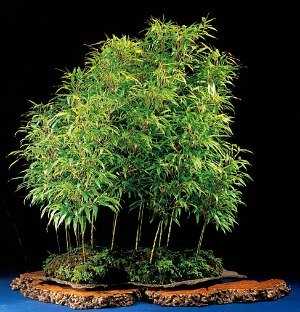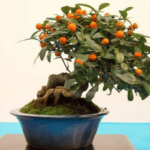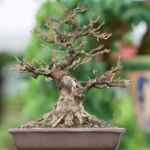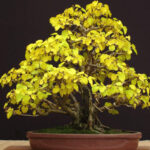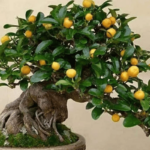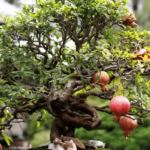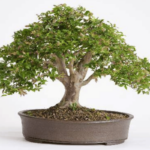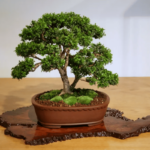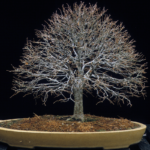Bamboo bonsai is one of the most intriguing bonsais to cultivate.
Due to its lack of branches, you cannot style the plant as with other bonsais, but you can achieve a forest-like appearance by planting multiple bamboos closely together.
There are over 10,000 species of bamboo found worldwide, thriving in regions with both high and moderate temperatures.
Because of its rapid growth, only a few bamboo species are suitable for bonsai cultivation:
- Bambusa ventricosa (Buddha Belly Bamboo): commonly known as Buddha Belly bamboo.
- Bambusa multiplex (Tiny Fern Bamboo): popularly known as fern leaf bamboo, and is highly recommended for beginners.
- Pleioblastus fortunei (Dwarf Whitestripe / Golden Bamboo): a species with more gentle growth, making it an excellent choice for bonsai. It features thin green leaves that turn yellow in the autumn.
- Pseudosasa owatarii (Dwarf Bamboo): an excellent option for bonsai, also highly cold-resistant.
- Bambusa guangxiensis (Chinese Dwarf Bamboo): has dark green leaves that maintain their color year-round. Bonsais of this species prefer warmer climates.
In addition to these species, there are also 2 well-known types of bonsais referred to as bamboo bonsais, but in reality, these plants are not bamboo.
- The lucky bamboo is a dracaena sanderiana.
- The heavenly bamboo is a small shrub called nandina.
In this article, you will learn more about the cultivation and characteristics of these bamboo bonsais.
Cultivation of Bamboo Bonsai
First, let me explain a bit more about cultivating bonsais that are truly made with bamboo species.
Then, you’ll learn more about lucky bamboo and heavenly bamboo.
Where to Plant
If you live in tropical environments where the cold is not extreme, it’s ideal to cultivate your bamboo bonsai outdoors throughout the year.
Other crucial aspects are the lighting and humidity you provide for your bamboo.
These plants thrive in high humidity and ample light, so make sure the location where you place your bonsai has these characteristics.
Tip: there are plants that can increase air humidity, check them out in this article.
If you’re in an environment with harsh winters, you might need to bring your bamboo bonsai indoors during these periods, but remember to offer good lighting and humidity.
How to Water
Bamboo bonsai grows rapidly and needs more frequent watering compared to most bonsais.
Water your bonsai generously when the soil becomes dry.
After watering, the soil should be moist but never waterlogged.
Keep in mind that watering frequency can vary due to factors such as:
- Time of year
- Climate
- Pot size
Ideal Temperature
The ideal temperature for this type of bonsai can vary based on the cultivated species.
The majority of species thrive better in tropical climates and slightly higher temperatures.
However, there are species that prefer colder climates.
Therefore, seek more information about the specific species you’re cultivating.
How to Fertilize
Bamboo is a fast-growing plant, and when cultivating it as a bonsai, we don’t want to stimulate its growth excessively.
Hence, fertilization, despite being essential, should be done moderately.
Apply a balanced fertilizer to your bamboo bonsai only during its growth season, which spans from spring to the end of autumn.
Remember to follow the instructions on your fertilizer’s packaging.
Pruning
Frequent pruning is necessary to maintain your bamboo bonsai’s appropriate size.
Here are some tips that might help:
- Prune during the growth period (spring/summer).
- Use proper pruning tools and ensure they’re sterilized.
- Begin by removing dead or diseased leaves and branches.
- Then, trim overgrown branches, leaving the buds.
- Root pruning should also be done regularly.
Transplanting
Repotting is a necessary step to sustain the health and development of your bamboo bonsai.
To determine if it’s time to repot your bonsai, check if the bamboo’s roots are coming out of the pot. Typically, this occurs every 1 or 2 years due to the rapid root growth of this plant.
Repotting should be done during the bamboo’s growth period (spring/summer).
Remember: it’s normal for the bamboo bonsai to lose some leaves after repotting.
Meet the Lucky Bamboo
Let’s begin with the most common one, lucky bamboo or dracaena sanderiana.
Despite being called a bamboo bonsai, this plant is not a bamboo.
It is very resilient and grows rapidly, making it an excellent choice for beginner cultivators.
Lucky bamboo got its name because many believe it brings luck to its owners.
To cultivate this plant, follow the advice below:
- Avoid exposing it to very cold temperatures
- Prune it during winter (remove all leaves)
- This species thrives when planted in soil but can also be grown in water.
- Provide indirect lighting
Meet the Heavenly Bamboo
Heavenly bamboo or sacred bamboo is a very small shrub whose true name is nandina.
This plant is native to eastern Asia and possesses some very interesting characteristics.
First among them are its leaves, which change color throughout its life cycle, including:
- Red
- Green
- Pink
- Purple (when dying)
Before deciding to cultivate this plant, you should be aware that it can be toxic to some animals.
Therefore, if you have cats, horses, goats, or other animals (especially grazing animals), opt for another plant to cultivate.
If you choose to cultivate this plant, you can follow the advice below:
- Provide plenty of warmth and sunlight; it thrives in full outdoor sunlight.
- Water it daily.
- Fertilize every 2 weeks with bonsai-specific fertilizer.
- Repot in spring, removing excessively large roots.
- Plant it in well-draining soil.
Cultivating this plant can be highly rewarding, especially for beginners.
Conclusion
I hope that with this article, you’ve gained a better understanding of bamboo bonsais.
And if you want to learn more about bonsais, explore the articles below:
- Main Problems in Bonsais – Yellowing, Drying, Falling Leaves
- Orange Bonsai – How to Easily Cultivate and Care For
- Pomegranate Bonsai – How to Care in 6 Simple Steps
- Jabuticaba Bonsai – Step by step to having fruits
- Boxwood Bonsai (Buxus) – Step-by-Step Care Guide
- Lemon Bonsai – Discover How to Easily Cultivate Them
If you enjoyed this article, please share it on your social media by clicking the icons below.

